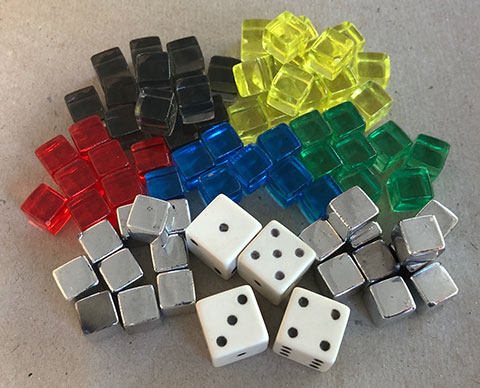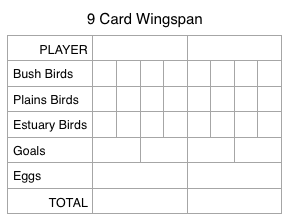Continued from 9 Card Wingspan – An Overview
An important part of turning a big box game into a 9 card PnP is cutting down the other components and the play time to match. So let’s look at some numbers.
Number of Turns
Wingspan is played over 4 rounds, with 26 total turns. I’m initially going to make it last 2 rounds, of 7 and 6 turns, for a total of 13. Each player tracks actions during each round with cubes, so we’ll need 7 cubes, in 2 colours, instead of the 5 x 8 cubes the original game has.
Bird Placement
However, in the 9 card game, we’ll need cubes to mark bird placement for each player. 8 should be plenty, in a 13 round game, so that’s another 16 we need.
Food types
There are 5 different food types in the original. I toyed with cutting it down to 2, plant and animal/herbivore and carnivore, but that seems too simplistic. So we’ll make it 3; insect, berry and fish; represented by cubes of green, red and blue. The game has around 20 of each food type for a 5 player game, so let’s start with 8 of each cube for a 2 player game, for 24 cubes, instead of 103 tokens.

Eggs
Each player in Wingspan has 15 eggs. We have a smaller board, with each nest capped at 2 eggs, and only 13 total rounds, so I think 10 each might be enough, so 20 of those, instead of 75.
Total of 74 cubes, instead of 218 cubes/tokens/eggs.
Dice
There are 5 very nice custom dice (which have the different foods on the faces), and a fabulous bird feeder/dice tower in the original. I think 4 might be enough in a 2 player game, and obviously we want to be able to use regular dice in our game. 1,2 for insect, 3,4 for berry, 5,6 for fish.
And I think that should be it for outside components.

Goal board and Bonus Cards
There are 2 kinds of scoring bonuses earned during the original Wingspan. There are 4 common end of round Goals, that all the players work towards, and there are individual end of game Bonuses. The Goals are generic kind of things; eggs in a certain nest type, birds in a specific habitat; that kind of thing. The end of game Bonuses are more specific, and are often about the bird cards in your habitat; birds with a colour in their name, birds of a certain size, etc. The Bonuses aren’t really something we can use in the 9 card version. Bird cards aren’t placed on the player boards, making it much harder to track those specifics.
Therefore the bonus squares on the bird cards will be end of round Goals. And because these Goals are common, I think they will work in the following way.
Shuffle the bird cards, deal 1 to each player, who then turns it over. The 5 birds on each players card are “in their hand”, and are only available to them. The top right corners contain the goal, and each goal is for both players. Both players will gain bonus points, from both Goals revealed at the start of the game.
Round 2 will start the same way, with 2 more common Goals available for the players. This way they will still get 4 Goals during the game, but I think it will be split up a little, because they won’t really have the time to work on both.
Score Pad
As bird cards don’t get collected on to the Player Boards during the game, the points for each bird need to be noted as you go. An adjusted score pad will have an empty square for each space on the Player Board, so you can write in the points as each bird is added. Plus 2 spaces for the end of round Goals and 1 to tally up all the eggs at the end of the game.

That’s all the components. Next post will be focusing on the mechanics that need adjusting.
Continued in 9 Card Wingspan – Mechanics and a Name
